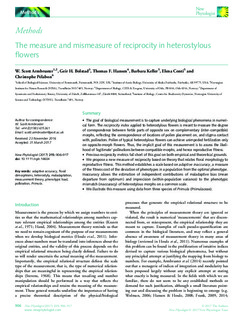The measure and mismeasure of reciprocity in heterostylous flowers
Armbruster, W. Scott; Bolstad, Geir H.; Hansen, Thomas F.; Keller, Barbara; Conti, Elena; P elabon, Christophe
Journal article, Peer reviewed
Accepted version

Åpne
Permanent lenke
http://hdl.handle.net/11250/2453494Utgivelsesdato
2017Metadata
Vis full innførselSamlinger
- Scientific publications [1392]
Sammendrag
The goal of biological measurement is to capture underlying biological phenomena in numericalform. The reciprocity index applied to heterostylous flowers is meant to measure the degree of correspondence between fertile parts of opposite sex on complementary (inter-compatible) morphs, reflecting the correspondence of locations of pollen placement on, and stigma contact with, pollinators. Pollen of typical heterostylous flowers can achieve unimpeded fertilization only on opposite-morph flowers. Thus, the implicit goal of this measurement is to assess the likelihood of ‘legitimate’ pollinations between compatible morphs, and hence reproductive fitness. Previous reciprocity metrics fall short of this goal on both empirical and theoretical grounds. We propose a new measure of reciprocity based on theory that relates floral morphology to reproductive fitness. This method establishes a scale based on adaptive inaccuracy, a measure of the fitness cost of the deviation of phenotypes in a population from the optimal phenotype. Inaccuracy allows the estimation of independent contributions of maladaptive bias (mean departure from optimum) and imprecision (within-population variance) to the phenotypic mismatch (inaccuracy) of heterostylous morphs on a common scale. We illustrate this measure using data from three species of Primula (Primulaceae).